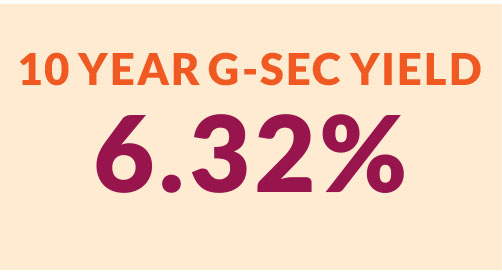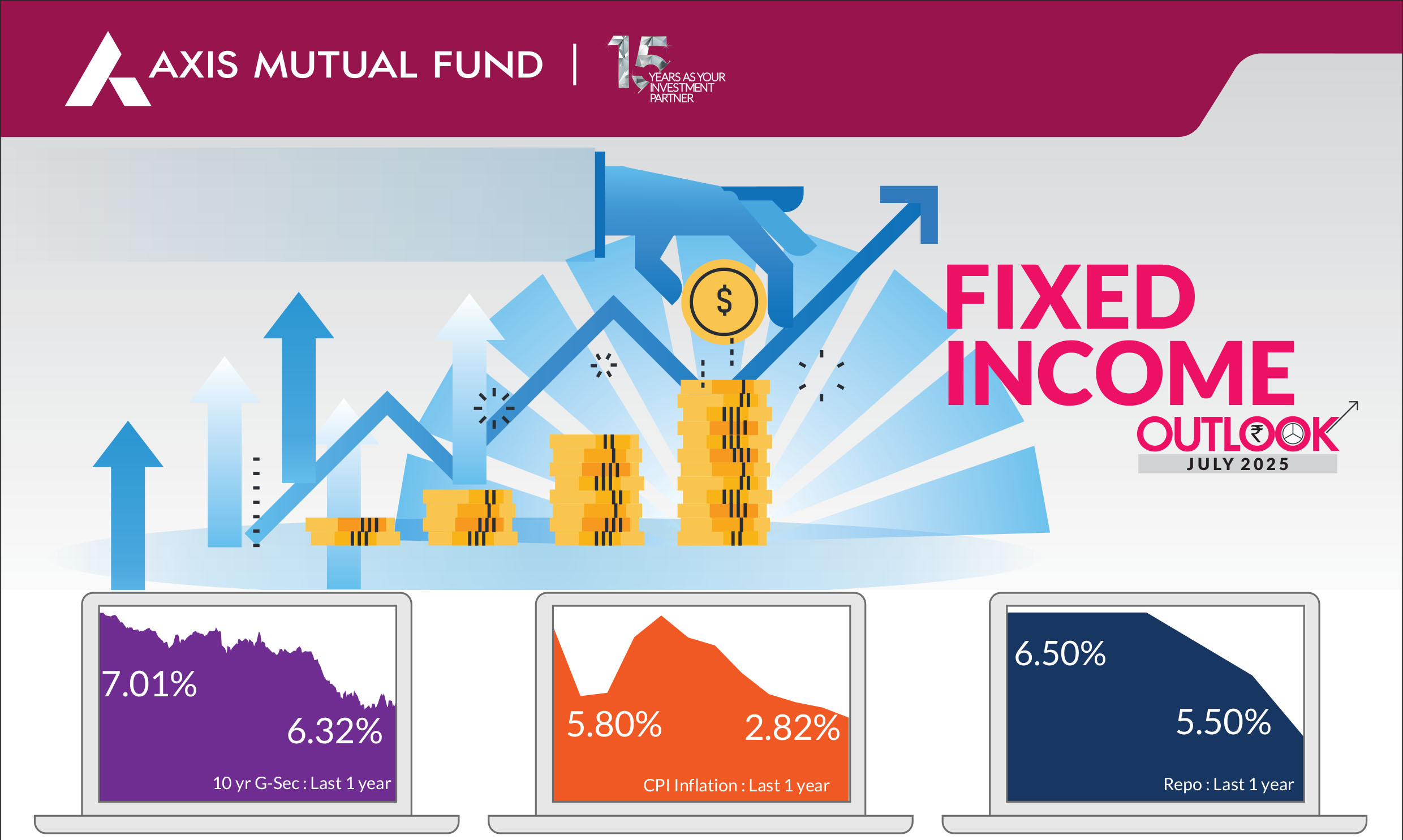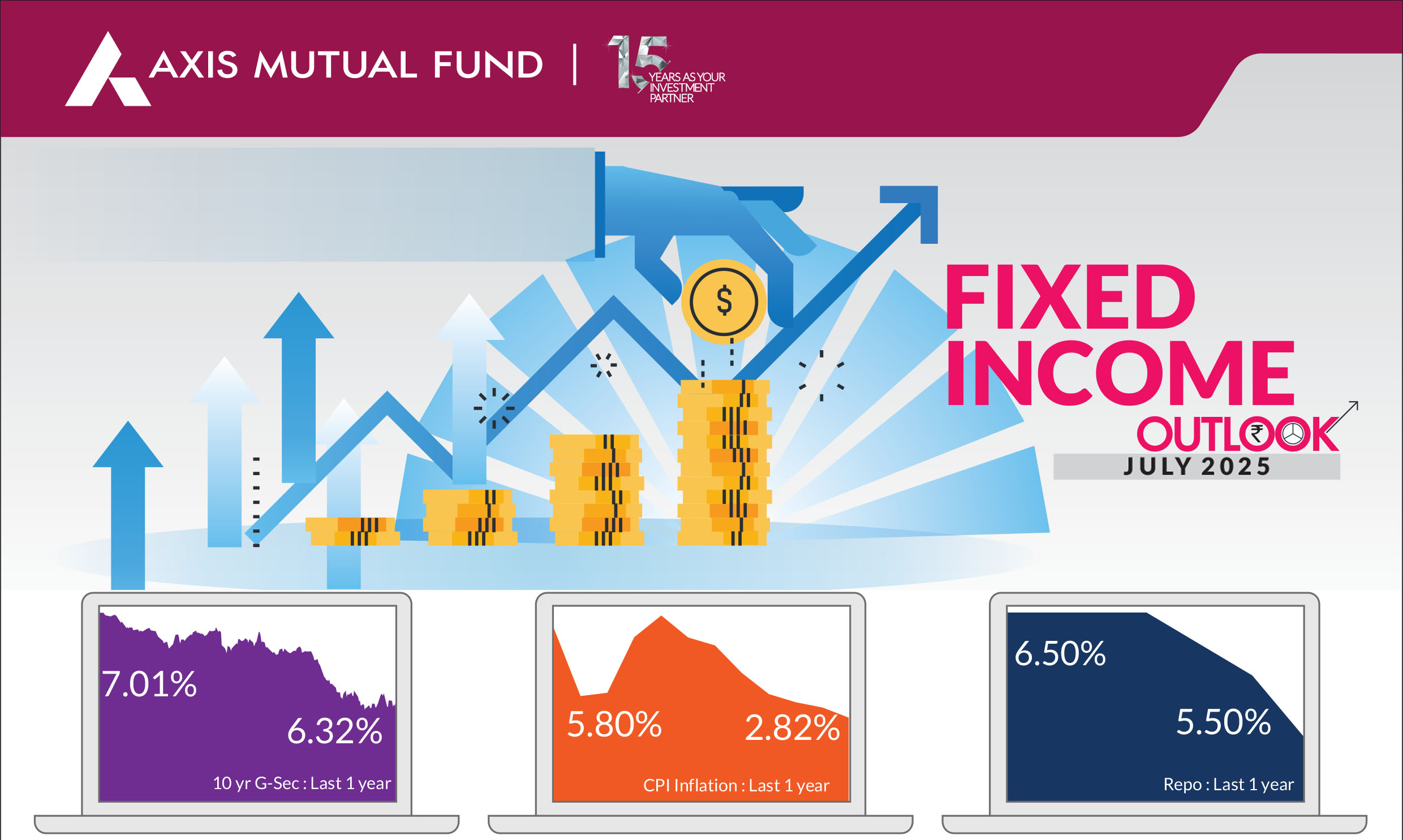•
Rate cycle on a pause for the
next few policies.
• Yield upside limited; investors
should add duration with every
rise in yields.
•
Mix of 8-10 yr Gsecs and short
term 1-5-year corporate bonds
are best strategies to invest in
the current macro environment.
•
Selective Credits continue to
remain attractive from a risk
reward perspective given the
improving macro fundamentals.
The month saw geopolitical conflicts in Israel Iran that led to investors opting for safer havens such as bonds and gold. Overall, 10 year Treasuries ended 17 bps lower at 4.23%. In India, the 10-year government bond yields ended 3 basis points higher at 6.32% given abundant banking liquidity and receding inflation.
Banking liquidity in surplus :
Banking liquidity remains in surplus prompting the
Reserve Bank of India (RBI) to conduct a seven day VRRR auction to the tune of Rs
84,975 cr. The higher surplus liquidity in the banking system is forcing overnight
rates in the market to trade below the
Standing Deposit Facility (SDF), which the
central bank wants to align it with the repo
rate. Overall, the yield curve has steepened
since the monetary policy action in early
June.
Inflation falls further : Headline inflation fell to 2.8% in May from 3.1% in April, led by a faster than expected moderation in food prices especially vegetables. The IMD's forecast of an above-normal monsoon is likely to support the crop harvests, which, in addition to the healthy buffer stocks, is likely to ensure that food prices remain benign. We expect headline inflation to remain near 3% or below over the next few months driven by benign food prices and due to favourable outlook for crop production. Crude oil prices rose sharply and witnessed an equally sharp reversal following the de-escalation in geopolitical tensions.
Inflation falls further : Headline inflation fell to 2.8% in May from 3.1% in April, led by a faster than expected moderation in food prices especially vegetables. The IMD's forecast of an above-normal monsoon is likely to support the crop harvests, which, in addition to the healthy buffer stocks, is likely to ensure that food prices remain benign. We expect headline inflation to remain near 3% or below over the next few months driven by benign food prices and due to favourable outlook for crop production. Crude oil prices rose sharply and witnessed an equally sharp reversal following the de-escalation in geopolitical tensions.

Macro data mixed :
May industrial production growth slowed to 1.2% vs 2.6% in the
previous month. Growth was subdued due to sluggish growth in Mining and
Electricity sector which contracted by 0.1% and 5.8% respectively. Manufacturing
grew by 2.6% in May. Meanwhile, India's current account surplus of 1.3% of GDP in
Q4FY25 was the strongest seen in any fourth quarter since FY09. The usual
seasonal pickup was bolstered by services-exports, lower dividend outflow, and
front-loading of goods-exports pre-US tariffs.
Rupee little changed in June : Rupee stayed unchanged through the month against the US dollar. However, the US dollar lost ground against most currencies in June and on a year to date basis, was 8% down.
US treasury yields move lower : The yields on US Treasuries fell 17 bps over the month ending at 4.23% as geopolitical stresses eased. Meanwhile the US Federal Reserve has indicated that it is taking a patient approach bt a rate cut could be on the horizon based on incoming data.
Rupee little changed in June : Rupee stayed unchanged through the month against the US dollar. However, the US dollar lost ground against most currencies in June and on a year to date basis, was 8% down.
US treasury yields move lower : The yields on US Treasuries fell 17 bps over the month ending at 4.23% as geopolitical stresses eased. Meanwhile the US Federal Reserve has indicated that it is taking a patient approach bt a rate cut could be on the horizon based on incoming data.
Market view
After the larger-than-expected repo rate cut, shift to "neutral stance' from 'accommodative' and unexpected CRR cut, markets remain in neutral. Liquidity remains abundant and we do not anticipate further cuts in the next 3-6 months. Recently, the central bank conducted a 7 day VRRR to remove the volatility in the overnight /operative rates. As mentioned earlier, the higher surplus liquidity in the banking system forced overnight rates in the market to trade below the Standing Deposit Facility (SDF).Furthermore, we anticipate that maintaining sustained liquidity of 1% of NDTL or higher coupled with slow credit growth will lead to a rally in short end of the fixed income curve and result in a steeper yield curve. Consequently, we expect 1-5-year corporate bonds to rally and outperform long bonds on a risk reward perspective. Additionally, we foresee a limited rally in government bonds going forward, as we expect a shallow rate cut cycle and incremental OMO purchases to be limited to Rs 1-1.5 trillion.
As we have been indicating, a significant part of the bond market rally is behind us and expect macro indicators like GDP, CPI to remain soft for FY26. Consequently, there is nothing that can lead to significant upside in yields. Historically we have witnessed a 100-125 basis points bond rally in an easing cycle. We have already seen yields lower by 70-75 bps over last 12 months. Hence we expect limited rally from hereon. Once there is a resolution on US tariffs, and if they are significantly rolled back, the rally in India bond markets will likely be done. This is because clarity will emerge on CPI, and one will be able to gauge the impact on growth and start pricing terminal rate cut. Given the surplus liquidity, we expect the short bonds to outperform longer duration.
On the global front, while the tariff uncertainty has come down, countries are using the cool off period to negotiate. Whle the Fed has remained shy of lowering rates in last few months, we do expect two rate cuts this year. The US will see its growth slowing down and indicators like a weak labour market could be an indication. Meanwhile, tariffs could lower growth and this could mean rate cut cycle of 75-100 bps.
Risks to our view: The risks to our view at this point are as below
1) Currency risk
2) Trade wars
Strategy - Strategy - We have been maintaining a higher duration across all our funds and guiding the rally in bonds since March 2024. We have already witnessed more than 80 bps of rally in 10-year bonds since early 2024. Although positive demand-supply dynamics for government bonds and expected rate cuts will continue to keep bond markets happy, from hereon we expect a limited rally in the next 3-6 months. Directionally we see yields for the 10-year Gsec to trade in a range of 6%-6.40% in the next 6 months. Corporate bond yield for AAA rated firms for notes due in 3-10 years will trade in a band of 6.50% and 6.75%; effectively we have 50-100 bps of incremental gains in this segment.
We anticipate that the RBI will maintain its emphasis on ensuring positive system liquidity going forward. Due to favourable demand supply dynamics and OMOs, we continue to have a higher bias towards government bonds in our duration funds.
We have been adding 1-5 year corporate bonds to the portfolio as we expect surplus banking liquidity, lower supply of corporate bonds/ CDs due to slowdown and delay in implementation of LCR guidelines and attractive spreads and valuations. Incrementally short bonds can outperform long bonds from risk risk-reward perspective due to a shallow rate cut cycle, lower OMO purchases in the second half of the year and a shift in focus to Govt Debt to GDP targets.
What should investors do?
• In line with our core macro view, we continue to advise short- to medium-term funds with tactical allocation of gilt funds to our clients.
Source: Bloomberg, Axis MF Research.


